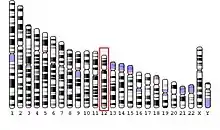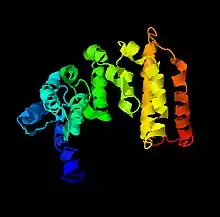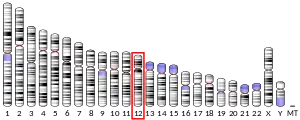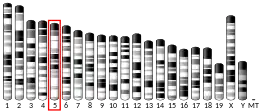C12orf24
C12orf24 (Chromosome 12, Open Reading Frame 24) is a gene in humans (Homo sapiens) that encodes a protein known as FAM216A.[5] This gene is primarily expressed in the testis and brain, but has constitutive expression in 25 other tissues.[5][6] FAM216A is an intracellular protein that has been predicted to reside within the nucleus of cells.[7] The exact function of C12orf24 is unknown. FAM216A is highly expressed in Sertoli cells of the testis as well as different stage spermatids.[8]
| FAM216A | |||||||||||||||||||||||||||||||||||||||||||||||||||
|---|---|---|---|---|---|---|---|---|---|---|---|---|---|---|---|---|---|---|---|---|---|---|---|---|---|---|---|---|---|---|---|---|---|---|---|---|---|---|---|---|---|---|---|---|---|---|---|---|---|---|---|
| Identifiers | |||||||||||||||||||||||||||||||||||||||||||||||||||
| Aliases | FAM216A, C12orf24, HSU79274, family with sequence similarity 216 member A | ||||||||||||||||||||||||||||||||||||||||||||||||||
| External IDs | MGI: 1916198 HomoloGene: 8328 GeneCards: FAM216A | ||||||||||||||||||||||||||||||||||||||||||||||||||
| |||||||||||||||||||||||||||||||||||||||||||||||||||
| |||||||||||||||||||||||||||||||||||||||||||||||||||
| |||||||||||||||||||||||||||||||||||||||||||||||||||
| |||||||||||||||||||||||||||||||||||||||||||||||||||
| Wikidata | |||||||||||||||||||||||||||||||||||||||||||||||||||
| |||||||||||||||||||||||||||||||||||||||||||||||||||
 Chromosome 12 | |
| C12Orf24 | |
|---|---|
| Alliases | FAM216A, HSU79274 |
| External IDs | NCBI: NM_013300.3 |
Gene
Locus
C12orf24 is a protein-encoding gene found on the forward strand of chromosome 12 at the locus 12q24.11. C12orf24 is located on the long arm of chromosome 12.[9]
mRNA
FAM216A has 2 isoforms X1 and X2 that are both shorter than the main protein, which is known as FAM216A. Isoform X2 has 2 variants which are the same length and isoform X1 only has 1 variant.[5]
| Name | Transcript ID | base pair length | Protein Length |
|---|---|---|---|
| FAM216A | NP_037432.2 | 1,101 | 273 |
| FAM216A_X1 | XP_011536548.1 | 1,148 | 234 |
| FAM216A_X2 | XP_024304727.1 | 1,142 | 179 |
| FAM216A_X2 | XP_005253932.1 | 1,040 | 179 |
Size
Chromosome 12 is a medium-sized chromosome, on which C12orf24 spans from 110,468,415 to 110,490,387 which is 21,973 bases long. The resulting mRNA transcript is 1,101 bases, 822 of which is the coding sequence. The resulting protein is 273 amino acids long.[10][5]
| Exon | Start | End | Length In Base Pairs |
|---|---|---|---|
| ENSE00001474815 | 110,468,845 | 110,469,018 | 174 |
| ENSE00003514548 | 110,473,078 | 110,473,077 | 41 |
| ENSE00003459833 | 110,485,078 | 110,485,199 | 122 |
| ENSE00003639607 | 110,486,325 | 110,486,454 | 130 |
| ENSE00003553453 | 110,486,534 | 110,486,717 | 184 |
| ENSE00003571489 | 110,487,861 | 110,487,943 | 83 |
| ENSE00003568139 | 110,490,019 | 110,490,385 | 367 |
Gene Regulation
Promoter
According to the UCSC Genome Browser and Genomatix Eldorado there are two promoters of C12orf24 and no enhancers or other regulatory elements.[13][14] Only one of the two predicted promoters binds transcription factors.[14]
Transcription Factors
There are many transcription factors predicted to bind to the promoter region of C12orf24 by Genomatix and the UCSC Genome Browser.[14][13]
| Name | Function | Binding Sequence |
|---|---|---|
| ZKSCAN3 | C2H2 zinc finger transcription factors 2 | ccctcCCCCaccgtaactccggg |
| SPZ1 | Testis-specific bHLH-Zip transcription factors | aGGAGggaaat |
| WT1 | Wilms tumor suppressor | cggtgggGGAGgggcagga |
| E2F7 | Cell cycle regulator | cacaggaGGGAaatata |
| MZF1 | Myeloid zinc finger 1 factors | gcGGGGagcag |
| ETSF | Human and murine ETS1 factors | gtttgacaGGAAggtggctca |
| ZNF7 | C2H2 zinc finger transcription factors 18 | cgggaGGCTgaggca |
| NKX2 | NKX homeodomain factors | gccctcAAGTgagaggcgg |
| MYOD | Myoblast determining factor |
ctgggaCAGCtgctccc |
Protein
Cellular Location
According to the PSORT program of Genescript, C12orf24 is 69.6% likely to be a nuclear protein.[7] NCBI Gene predicts that C12orf24 is an intracellular protein.[5]
Structure
Protein FAM261A has 2 charge runs, a positive run from amino acids 200-229 and a negative charge run from amino acids 238–268.[15] Methionine, histidine, and serine are all seen at a higher than expected rate in FAM216A while valine is seen at a significantly lower than expected rate.[15]
The CFSSP (Chou and Fassman Secondary Structure Prediction Server) predicts a secondary structure for FAM216A that has multiple alpha helices with a few large beta pleated sheets.[16][17] I-TASSER structure prediction program shows a 3D structure of FAM216A that has many alpha helices and a few coil turns with no beta pleated sheets.[18]

Protein Level Regulation
There are 8 predicted sites of sumoylation on FAM216A, with only 2 of them having a high probability of occurrence.[19] There are 7 predicted sites of glycation on FAM216A.[20] There is no predicted signal peptide for FAM216A, which may prevent the protein from being glycosylated.[21] There is 42 predicted sites for phosphorylation, however given the predicted structure of the protein not all 42 sites will be accessible for phosphorylation.[22]
Interacting Proteins
There are only a few known proteins that are predicted to interact with FAM216A.[23][24][25]
| Protein | Function |
|---|---|
| E6 | HPV type 8 protein that prevents apoptosis in infected cells |
| MAGEA10 | Possible roles in embryonal development, tumor transformation, and tumor development |
| DKC1 | Required for ribosome biogenesis and telomere maintenance |
| RCF4 | Replication factor C subunit 4. Possible required for elongation of multiprimed DNA |
| CCDC34 | Coiled-coil domain containing 34. Involved in the cell cycle |
| NIFK | Nucleolar protein interacting with the FHA domain of MKI67 |
| PSMA4 | Protease responsible for degrading most intracellular proteins |
Homology
Paralogs
The only paralog for FAM216A is FAM216B.[26]
Orthologs
According to the NCBI Gene page for C12orf24, there are at least 182 organisms with an ortholog of C12orf24.[27] The farthest back known orthologs are in sea corals which diverged from humans 824 million years ago.[28][29]
| Genus and Species | Common name | Taxonomic Group | Date of Divergence (MYA) | Accession Number | Sequence Length | Sequence Identity | Sequence Similarity |
|---|---|---|---|---|---|---|---|
| Pan paniscus | Bonobo | Primate | 6.7 | XP_003832531 | 281 | 95.7 | 96.1 |
| Pan troglodytes | Chimpanzee | Primate | 6.7 | PNI64720 | 256 | 92.7 | 93 |
| Gulo gulo | Wolverine | Carnivore | 96 | VCW50183 | 254 | 79.9 | 86.6 |
| Orcinus orca | Killer Whale | Odontoceti | 96 | XP_004276778 | 256 | 78.8 | 84.2 |
| Delphinapteruss leucas | Beluga Whale | Odonoceti | 96 | XP_022453741 | 256 | 78.4 | 84.2 |
| Mondon monoceros | Narwhal | Odontoceti | 96 | XP_029084711 | 256 | 78.4 | 84.2 |
| Tursiops truncatus | Bottlenose Dolphin | Odontoceti | 96 | XP_019806066 | 256 | 78.4 | 84.2 |
| Callhorhinus ursinus | Northern Fur Seal | Carnivore | 96 | XP_025745569 | 253 | 77.7 | 85 |
| Felis catus | House Cat | Carnivore | 96 | XP_003994705 | 253 | 75.5 | 84.2 |
| Puma concolor | Puma | Carnivore | 96 | XP_025789304 | 253 | 75.5 | 84.2 |
| Acinonyx jubatus | Cheetah | Carnivore | 96 | XP_026899980 | 253 | 75.1 | 84.2 |
| Equus asinus | Donkey | Equidae | 96 | XP_014714174 | 253 | 74.7 | 80.6 |
| Camelus ferus | Wild Bactrian Camel | Artidoctyla | 96 | XP_006178132 | 256 | 73.6 | 82.8 |
| Loxodonta africana | African Bush Elephant | Proboscidea | 105 | XP_010598175 | 254 | 76.2 | 83.2 |
| Ciona intestinalis | Sea Vase | Tunicata | 676 | XP_002124486 | 268 | 16.9 | 28.9 |
| Acanthaster planci | Crown-of-thorns Starfish | Echinodermata | 684 | XP_022109834 | 368 | 17 | 29.7 |
| Actinia tenebrosa | Australian Red Waratah Sea Anemone | Cnidaria | 824 | XP_031556553 | 433 | 16.1 | 24.8 |
| Pocillopora damicornis | Cauliflower Coral | Cnidaria | 824 | XP_027047953 | 415 | 16 | 23.7 |
| Orbicella faveolata | Mountainous Star Coral | Cnidaria | 824 | XP_020623330 | 435 | 15.4 | 23.2 |
References
- GRCh38: Ensembl release 89: ENSG00000204856 - Ensembl, May 2017
- GRCm38: Ensembl release 89: ENSMUSG00000029463 - Ensembl, May 2017
- "Human PubMed Reference:". National Center for Biotechnology Information, U.S. National Library of Medicine.
- "Mouse PubMed Reference:". National Center for Biotechnology Information, U.S. National Library of Medicine.
- "FAM216A family with sequence similarity 216 member A [Homo sapiens (human)] - Gene - NCBI". www.ncbi.nlm.nih.gov.
- "Genepaint - Home of High Resolution Gene Expression Data". gp3.mpg.de.
- "PSORT II server - GenScript". www.genscript.com.
- "Tissue expression of FAM216A - Staining in testis - The Human Protein Atlas". www.proteinatlas.org.
- "FAM216A Gene - GeneCards | F216A Protein | F216A Antibody". www.genecards.org.
- "Transcript: FAM216A-201 (ENST00000377673.10) - Exons - Homo sapiens - Ensembl genome browser 100". uswest.ensembl.org.
- "Tissue expression of FAM216A - Staining in cerebral cortex - The Human Protein Atlas". www.proteinatlas.org. Retrieved 2 May 2020.
- "Tissue expression of FAM216A - Staining in cerebral cortex - The Human Protein Atlas". www.proteinatlas.org. Retrieved 2 May 2020.
- "Genomatix: Annotation & Analysis". www.genomatix.de. Retrieved 2 May 2020.
- "Human hg38 chr12%3A110468611%2D110490386 UCSC Genome Browser v397". genome.ucsc.edu.
- "SAPS Results". www.ebi.ac.uk.
- "CFSSP: Chou & Fasman Secondary Structure Prediction Server". www.biogem.org. Retrieved 2 May 2020.
- Ashok Kumar, T. (2013). CFSSP: Chou and Fasman Secondary Structure Prediction server. WIDE SPECTRUM: Research Journal. 1(9):15-19.
- "I-TASSER results". zhanglab.ccmb.med.umich.edu. Retrieved 2 May 2020.
- "SUMOplot™ Analysis Program | Abcepta". www.abcepta.com. Retrieved 2 May 2020.
- "NetGlycate 1.0 Server - prediction results". www.cbs.dtu.dk. Retrieved 2 May 2020.
- "NetNGlyc 1.0 Server - prediction results". www.cbs.dtu.dk. Retrieved 2 May 2020.
- "NetPhos 3.1 Server - prediction results". www.cbs.dtu.dk. Retrieved 2 May 2020.
- "FAM216A protein (human) - STRING interaction network". string-db.org. Retrieved 1 May 2020.
- "Search Results – The Molecular INTeraction Database". Retrieved 1 May 2020.
- "PSICQUIC View". www.ebi.ac.uk. Retrieved 1 May 2020.
- "protein FAM216B [Homo sapiens] - Protein - NCBI". www.ncbi.nlm.nih.gov.
- "FAM216A family with sequence similarity 216 member A [Homo sapiens (human)] - Gene - NCBI". www.ncbi.nlm.nih.gov. Retrieved 2 May 2020.
- "BLAST: Basic Local Alignment Search Tool". blast.ncbi.nlm.nih.gov. Retrieved 2 May 2020.
- "TimeTree :: The Timescale of Life". timetree.org. Retrieved 2 May 2020.



